Alan Cathcart | March 24, 2019
Alan Cathcart Reviews the Fast and Affordable Lightning Strike E Sportbike
The Lightning Strike Motorcycle Corp. lets Alan Cathcart loose on its prototype new Lightning Strike E sport bike. It’s fast and affordable.
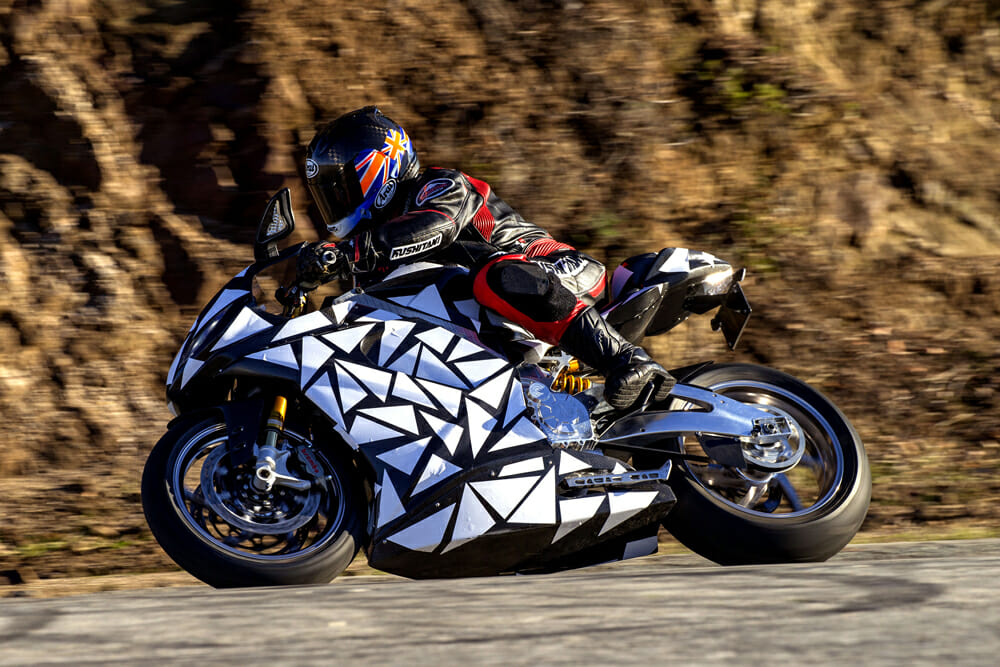 The Lightning Strike on the roads above Los Angeles, not too far from its headquarters in San Jose.
The Lightning Strike on the roads above Los Angeles, not too far from its headquarters in San Jose.
The past decade has seen an exponential increase in the availability, performance, range and recharging speed of electric-powered two-wheelers—but also in their price. EV Euro-leader BMW charges each U.S. customer for its C-evolution E-scooter a hefty $14,895, while an American-made Zero SR is listed at $16,495 for the base model, rising to $22,285 once you factor in a range-extending Power Tank and speedier-charging Charge Tank. And Harley-Davidson’s upcoming 2020-model LiveWire will be priced at even meatier $29,799. Listen, saving the planet will cost you. Unless…
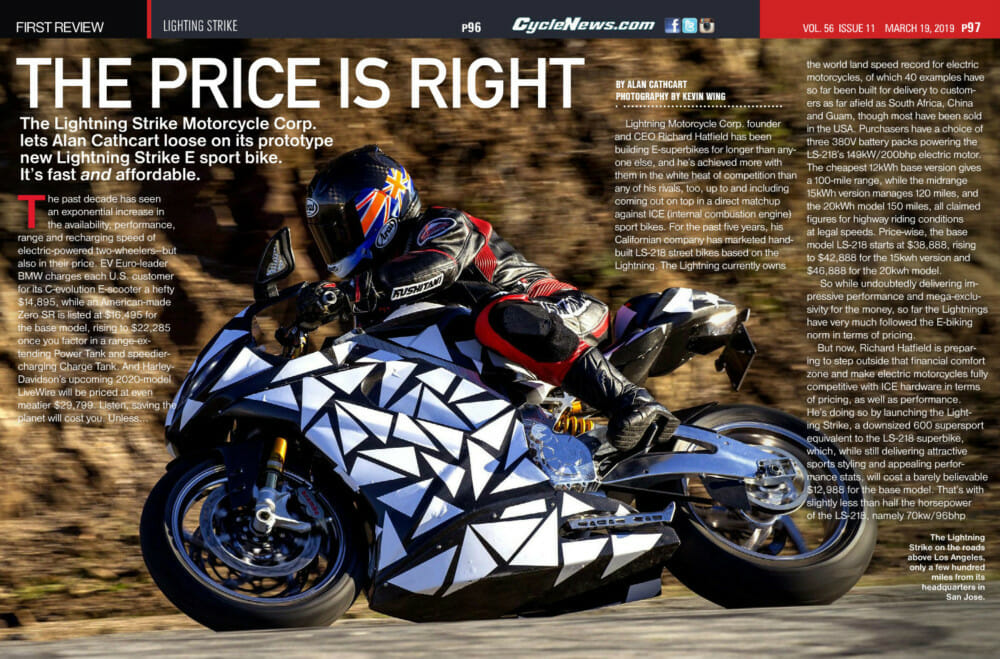
PHOTOGRAPHY BY KEVIN WING
Lightning Motorcycle Corp. founder and CEO Richard Hatfield has been building E-superbikes for longer than anyone else, and he’s achieved more with them in the white heat of competition than any of his rivals, too, up to and including coming out on top in a direct matchup against ICE/internal combustion-engined sport bikes. For the past five years, his Californian company has marketed hand-built LS-218 street bikes based on the Lightning. The Lightning currently owns the world land speed record for electric motorcycles, of which 40 examples have so far been built for delivery to customers as far afield as South Africa, China, and Guam, though most have been sold in the USA. Purchasers have a choice of three 380V battery packs powering the LS-218’s 149kW/200bhp electric motor. The cheapest 12kWh base version gives a 100-mile range, while the mid-range 15kWh version manages 120 miles, and the 20kWh model 150 miles, all claimed figures for highway riding conditions at legal speeds. Price-wise, the base model LS-218 starts at $38,888, rising to $42,888 for the 15kwh version and $46,888 for the 20kwh model. So while undoubtedly delivering impressive performance and mega-exclusivity for the money, so far the Lightnings have very much followed the E-biking norm in terms of pricing.
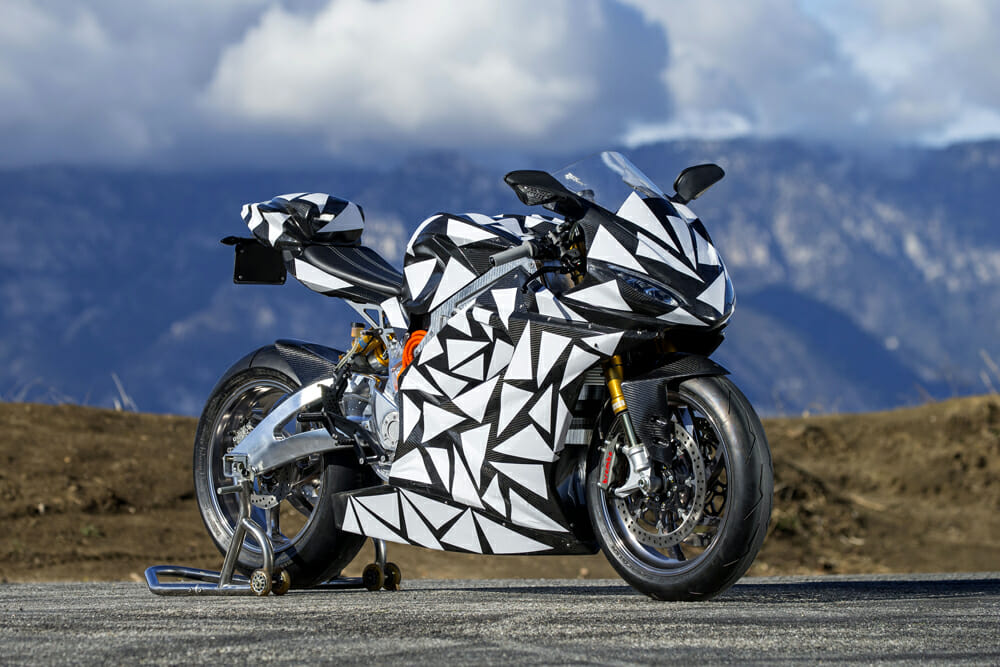 The L’ Strike it its disguise motif. It’s still a secret but we got to ride it anyway.
The L’ Strike it its disguise motif. It’s still a secret but we got to ride it anyway.
But now, Richard Hatfield is preparing to step outside that financial comfort zone and make electric motorcycles fully competitive with ICE hardware in terms of pricing, as well as performance. He’s doing so by launching the Lighting Strike, a downsized 600 supersport equivalent to the LS-218 superbike which, while still delivering attractive sports styling and appealing performance stats, will cost a barely believable $12,988 for the base model. That’s with slightly less than half the horsepower of the LS-218, namely 70kw/96bhp at 15,000 rpm at the output shaft of its liquid-cooled 150V three-phase AC induction motor made entirely by Lightning, with a liquid-cooled inverter/controller, rising to 90kW/120bhp from the more powerful 300V version that’s also available at a higher but yet-to-be-revealed price. Both versions deliver a constant 95Nm/69ft-lb of torque available from 1 rpm upwards and are powered by Lightning’s own battery packs using imported pouch-type lithium-ion cells, with an integrated thermal management system, and real-time data collection for managing the state of charge and state of health of each individual polymer cell.
The Strike’s range is claimed to be 120 miles in an Urban cycle with an 18kWh battery pack, and in the 75-90 mile range at Highway speeds, while Hatfield insists that recharging time from 5% to 95% can be under 40 minutes with a DC charger. Claimed wet weight is a contained (by EV standards) 455 pounds with all cooling fluids, 44 pounds less than the LS-218, split 52/48% along the Strike’s 55.9-inch wheelbase. And yes, Hatfield did have to pay Harley-Davidson a release fee to use the Lightning Strike name formerly registered to its defunct Buell brand. “It was more than we wanted to pay,” he says, “but not as much as I was fearing!”
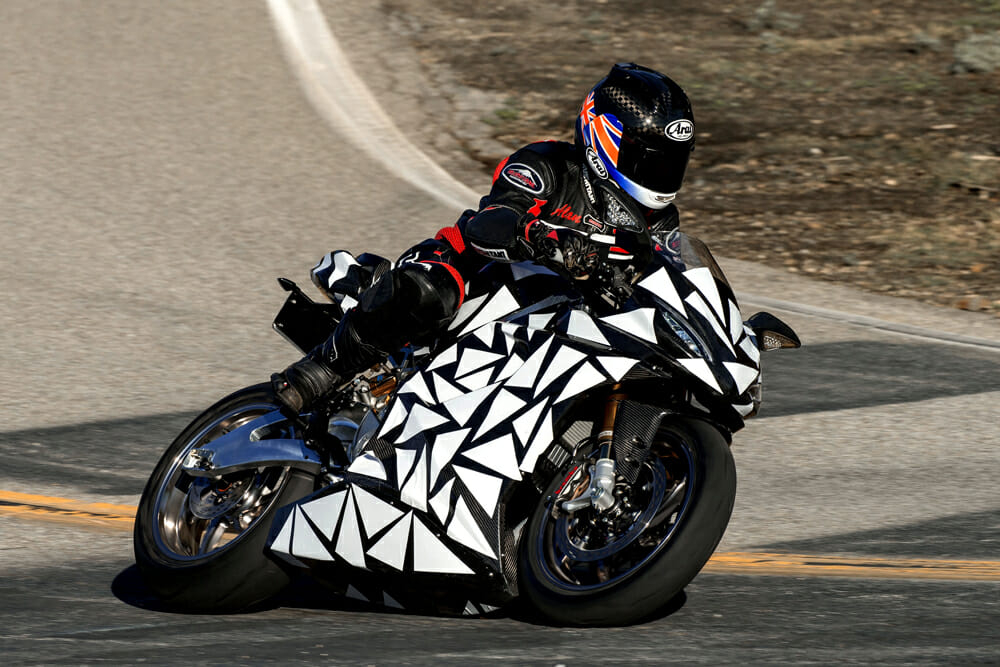 The electric-power Lightning Strike is all about performance at a reasonable price.
The electric-power Lightning Strike is all about performance at a reasonable price.
That $12,988 price tag for the E-Strike would be right on the money for a 600 Supersport, with the class-leading Yamaha R6 currently listed at $12,199 in the USA, so how the heck has Lightning managed to price the model so low by current EV standards? According to Hatfield, the Strike’s retail cost is feasible because of the complete restructuring of his company, including the opening of two new Lightning Motorcycle factories, each 20,000ft² in size. The first of these is in the heart of Silicon Valley in San Jose, California, just 20 miles from the Apple Campus in Cupertino, and is five times larger than Lightning’s previous base 40 miles further north in San Carlos, where LS-218 production was initiated. The other is in China, in the city of Quzhou south of Shanghai, and close to the QJ Benelli and KTM-CFMoto plants, as well as Moto Morini’s new owner Zhongneng’s HQ.
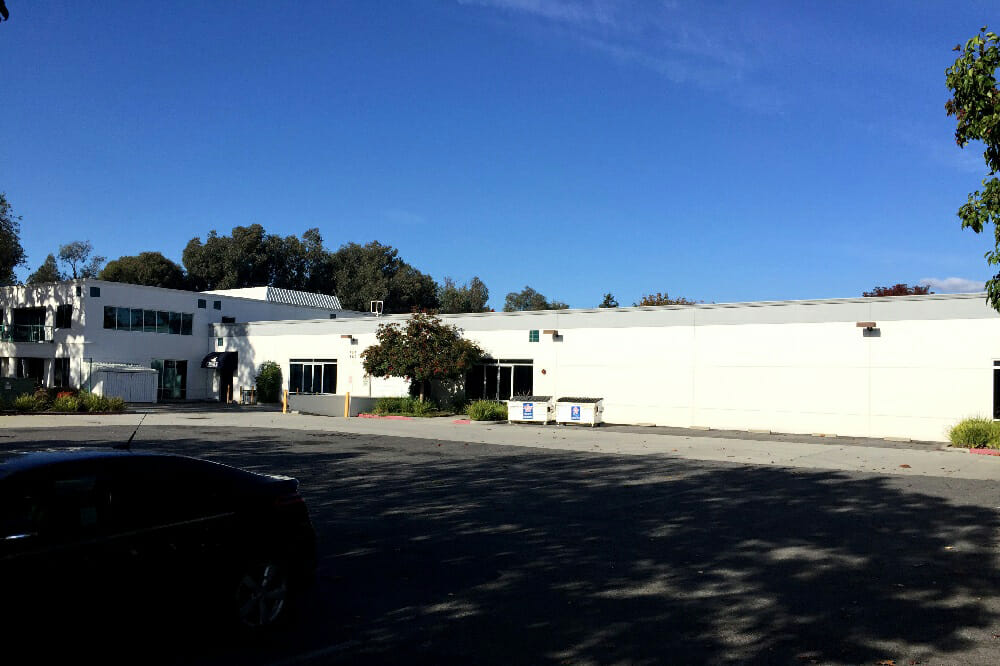 The Lightning Strike HQ in San Jose.
The Lightning Strike HQ in San Jose.
“Our main reason for opening the factory in China is that we know we must be able to build these bikes at a competitive price and in a kind of volume that will allow Lightning to compete with gasoline bikes on price,” explains Hatfield. “We’ll do the engineering and product development in California, but will manufacture the majority of the parts in China before shipping them to the USA, where we’ll assemble bikes destined for North America, and certain of our export markets. Then we’ll ship each motorcycle as a CKD/complete knockdown kit into our US dealers and our distributors in other countries, where they’ll hand assemble them locally. We’ll also build complete motorcycles in China for certain markets where it makes sense to do so geographically – not only China itself, which we see as a key market for Lightning but also India, in particular. China is definitely going to be one of the biggest markets in the world for electric motorcycles as opposed to scooters in the next few years, but we think India will be right there with them, basically to address the environmental problems that they face at present. There’s a lot of political will for electric motors in Central government in India, so they’re going to have ever more restrictive levels of emissions, and it’s going to be very difficult to make any viable cost-benefit of cheap gas bikes, going forward. Together, the two largest motorcycle markets in the world will both predominantly focus on electric motorcycles in the coming years, and Lightning will be there to serve them.”
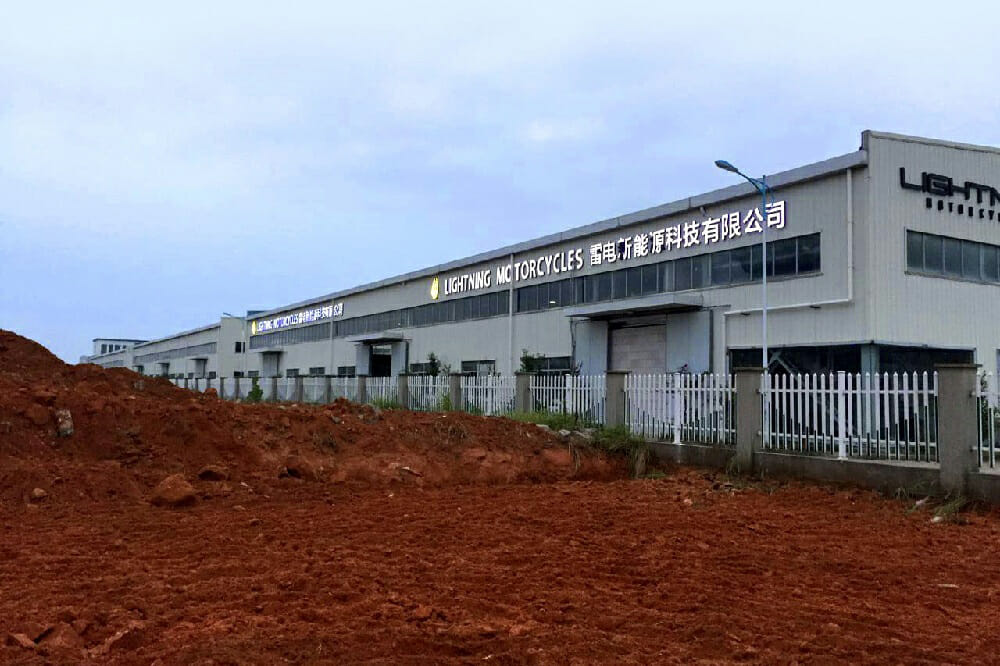 Designed in California, constructed in China.
Designed in California, constructed in China.
So mostly what Richard Hatfield is doing is to follow Apple’s strategy, and do the technology in Silicon Valley, then manufacture the end result in China. According to Hatfield, the Strike is scheduled to be unveiled in March, with the production of complete motorcycles to satisfy what he says are the many sight-unseen pre-orders Lightning already has for the bike, starting in June. Its debut will thus be the opening roll of the dice for a proven strategy, which, however, has never yet been applied to the motorcycle industry.
My opportunity to become the first person outside Lightning to ride the prototype Strike happened in Glendora, California, whose steep inclines and switchback sequential turns provide a stern test of handling and especially torque, ideal terrain to test an E-bike to best advantage, and even in raw, undeveloped form, the Lightning Strike didn’t disappoint.
However, at the stage in its development cycle which I rode it in, the prototype Strike was based on the architecture of the LS-218, with virtually the same chassis package including brakes and suspension, as well as styling derived from it. This led Hatfield to insist on covering it with camouflage tape, even if the end result was surely so noticeable as to shout—“I’m a prototype, photograph me!”
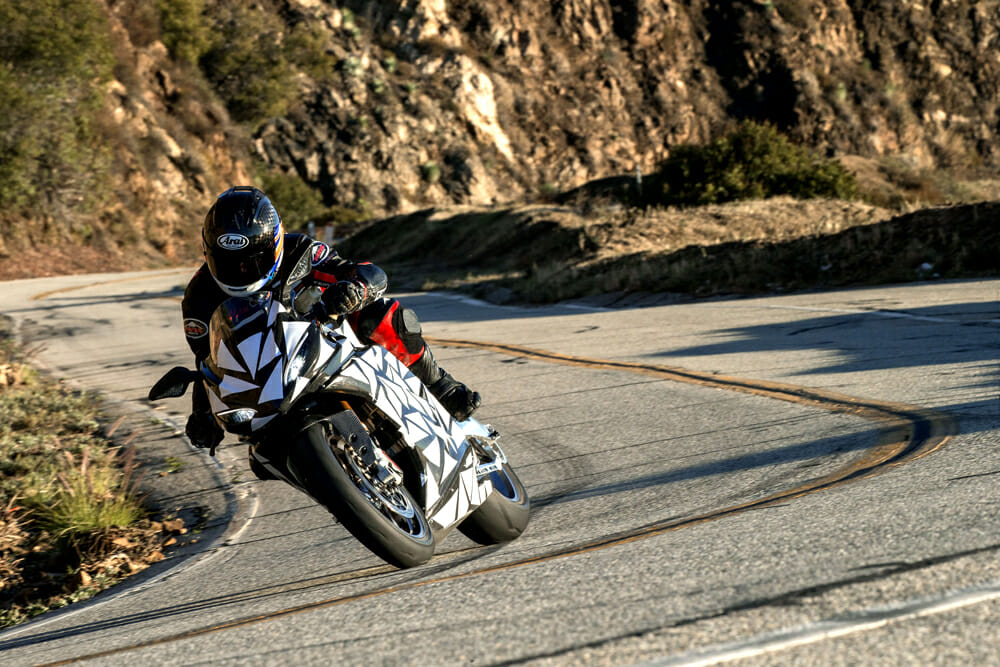 Cathcart found the bike to perform well but cockpit comfort needs some work before it goes into final production.
Cathcart found the bike to perform well but cockpit comfort needs some work before it goes into final production.
Riding the prototype Strike was a joy, even if there were inevitably several areas for improvement, principally in the rider packaging of the bike. However, since I was riding what was primarily a proof-of-concept model closely based on the LS-218, there’s lots of time for Lightning to address these issues before production commences, as they must. The chassis of the Strike was machined up in China by the array of hi-tech CNC machines in Lightning’s factory there, and that includes the beautifully crafted swingarm machined from solid aluminum billet. I wasn’t allowed to remove the LS-218 bodywork adapted to what is a much smaller motorcycle. So no chance to peer at the Strike’s array of batteries and assorted hardware, much less photograph these, although when deliveries begin Hatfield is aware he’ll have to accept exposing his technology for all to see.
Meantime, suffice to say that the Strike essentially consists of an aluminum shell housing the batteries which double as a monocoque frame. The prototype’s fully-adjustable Öhlins suspension will only be available on the high-end version of the Strike, and priced accordingly, says Hatfield—the much lower cost entry level model will most likely have Showa suspension. However, although the top quality Brembo Monoblock brake package on the prototype is also a straight carryover from the LS-218, Hatfield still plans to use lower spec Brembo brakes on the production version.
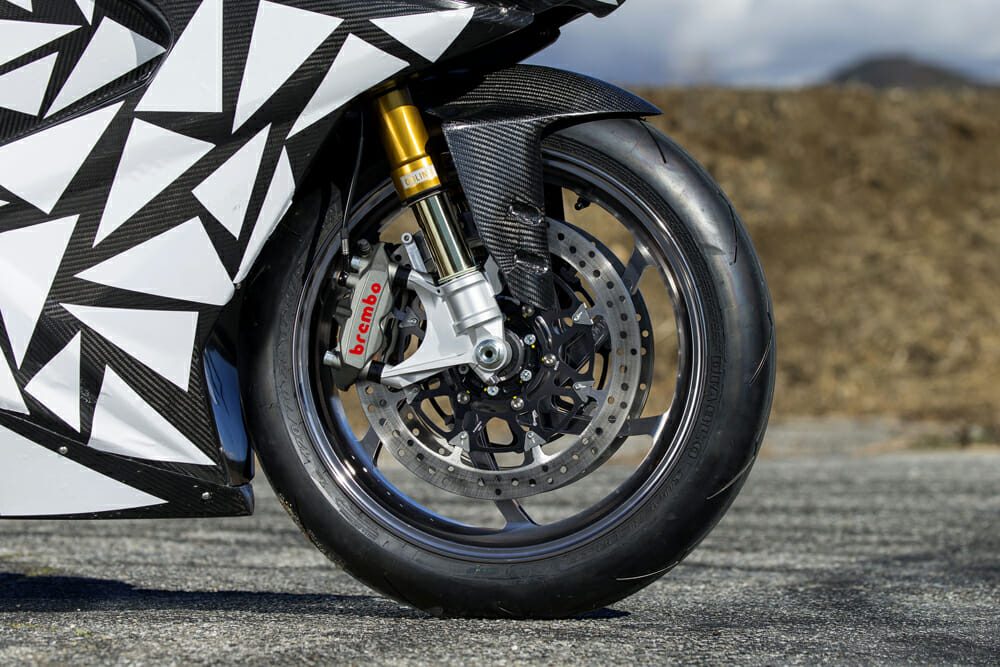 Stopping is provided by worthy Brembos.
Stopping is provided by worthy Brembos.
Climbing aboard the Strike immediately revealed a more comfortable, more rational and indeed more welcoming riding position than on the LS-218, particularly in terms of the width of the front part of the seat and the frame beneath it. On the bigger bike, this wasn’t just uncomfortable for any size of rider but meant that anyone of shorter stature would struggle to reach the ground at rest, even with one foot without leaning the bike over, let alone two. On the Strike, however, that’s not an issue, for in downsizing the bike to seven-eighths scale vs. the LS-218, Lightning has produced a motorcycle that’s immediately more congenial, even though at 32 inches the seat height is unchanged. However, said seat on the Strike was too inclined, so I couldn’t help sliding forward along it as far as the rear of the fake “fuel tank” shrouding the batteries. Its clipon handlebars are also set too flat (to avoid rubbing the bodywork lent it by the LS-218), and this meant I couldn’t easily push against them to counter the sliding seat. They need to be pulled back, anyway, which would also mean less of a stretch than at present across the top of the “fuel tank” to reach them. Finally, to complete a full critique of the Strike’s ergonomics, the footpegs are much too high even with the excellent grip delivered by the Pirelli Diablo Supercorsa rubber fitted to the forged aluminum wheels made to Lightning’s design, expect less costly but still grippy Pirelli Angel GT rubber to appear on production bikes. At 5’10” in height my legs were very cramped on the Strike, which not only compromised comfort but also prevented me moving about the bike as I wanted to do to hustle the Strike through the Glendora bends. It also meant that I could barely reach the front brake lever, instead relying on the rear brake pedal in its conventional place rather than on the left handlebar, scooter-style, to slow the Strike down.
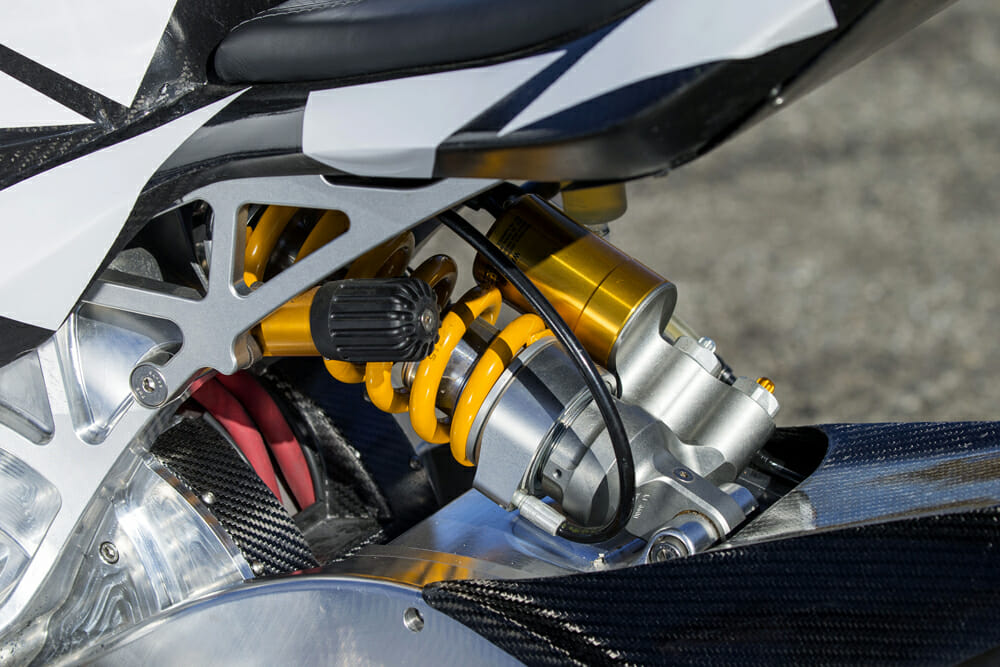 Ӧhlins suspension will be fitted to the high-end Lightning Strikes.
Ӧhlins suspension will be fitted to the high-end Lightning Strikes.
These criticisms merely amount to suggestions at the prototype stage, and for that reason, it’s also pointless to comment on the Strike’s brakes and suspension, since the hardware carried by this early prototype won’t reach volume production. But a close look at the seat/handlebar/footpeg triangle is needed, and Richard Hatfield realizes this. However, he’s got the Strike’s essential architecture dead right, though physically smaller and with more accessible performance from the half-as-powerful motor, it feels chuckable and agile in a way the heavier, much bulkier, and less nimble LS-218 could never be, despite the Strike sharing the same 24º rake/105.3mm trail steering geometry as the bigger bike.
But if the Strike’s chassis package needs some work, the motor is already just about spot on. After booting up the bike and going live, you must be ready for the traditional Lightning arm-lengthening acceleration, so hold on tight. Very tight! Acceleration isn’t as absolutely monstrous as on the LS-218, but thanks to the instant dose of substantial torque on tap as soon as you wind open the throttle, it’s still mighty impressive and far superior from rest to almost any other sport bike of whatever capacity. Okay, absolute top speed won’t be anywhere as fast as the LS-218, but that’s not the point of this real world E-motorcycle, which represents a new departure for Lightning—away from the outright performance, towards real-world rideability.
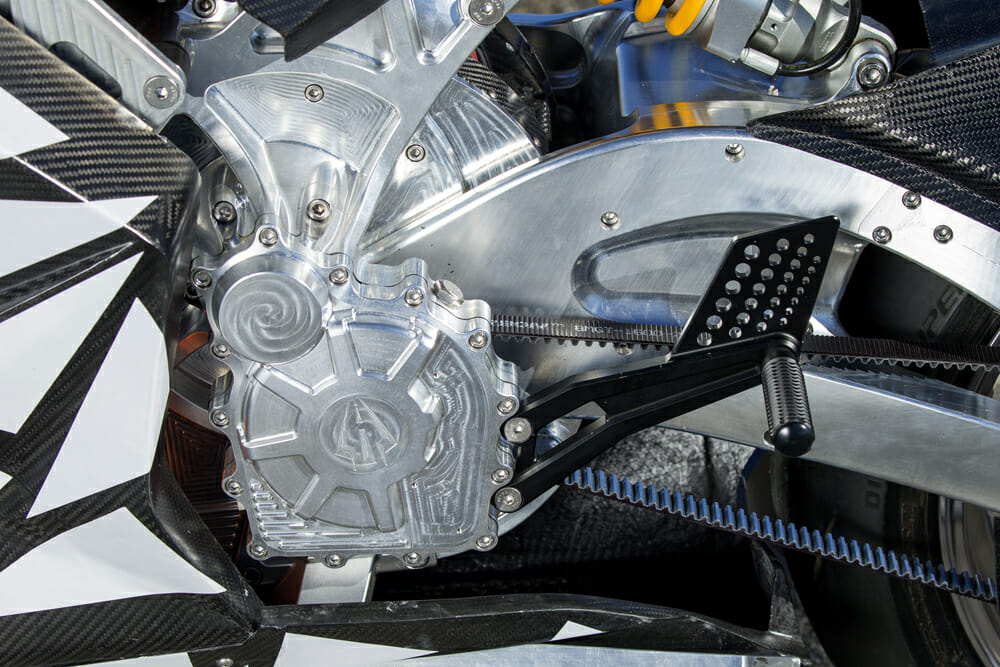 The motor delivers. When you open the throttle, you better be holding!
The motor delivers. When you open the throttle, you better be holding!
“We’re targeting the 650-800cc sector of gas-powered bikes with the Strike family of models,” says Hatfield. “So this is our mid-price, mid-performance, middleweight model with half the outright power and around 18% less battery than the LS-218—although we can also configure it with larger high-energy batteries for extra range. So we’ll have several options on that, and the same with the charger. Our base model has a 3.3kWh Level Two system, which takes roughly three and a half hours to charge from five percent to 95 percent, but we’ll also offer a 12 kWh charger which will reduce recharging time to roughly an hour, or we can use a DC fast charger which brings it down to 40 minutes. We’ll be giving each of our customers the opportunity to specify the exact overall package they’re looking for, which in most cases depends on their likely intended use for the motorcycle.”
Meantime, the Strike prototype delivered thrilling acceleration coupled with controllability at low speeds, and especially exiting a tight turn, with no trace of the brusque pickup mid-turn from a closed throttle of some E-bikes. The fact that the build of power and especially torque all the way to the 15,000 rpm limiter is so smooth and linear, with no spikes in the delivery ready to get the rear Pirelli unhooked via a sudden spurt of power as on an ICE Supersport, makes it feasible to exploit the reserves of performance of the Lightning motor. That’s thanks to the cleverly sanitized way that Hatfield & Co. have mapped the RBW/ride by wire throttle. While there’s quite a thrill to be had by winding the throttle wide open as soon as you get the Lightning moving, in normal riding the initial acceleration isn’t as fierce and vivid as on some other E-bikes, only coming on strong one you’ve got the Strike rolling, and speed up to around 30mph. “We’ve made the throttle response very progressive because we want the bike to be comfortable to ride on the street,” says Hatfield. “So the first 50% of throttle movement accesses less than 30% of the torque, but then when you want to push it harder, as you go up from the other 50% of throttle rotation as measured by a potentiometer inside the handlebar, it progressively delivers more and more torque. The software we use to programme the motor controller allows us to dial in the torque curve in this way, as well as to alter the regen.”
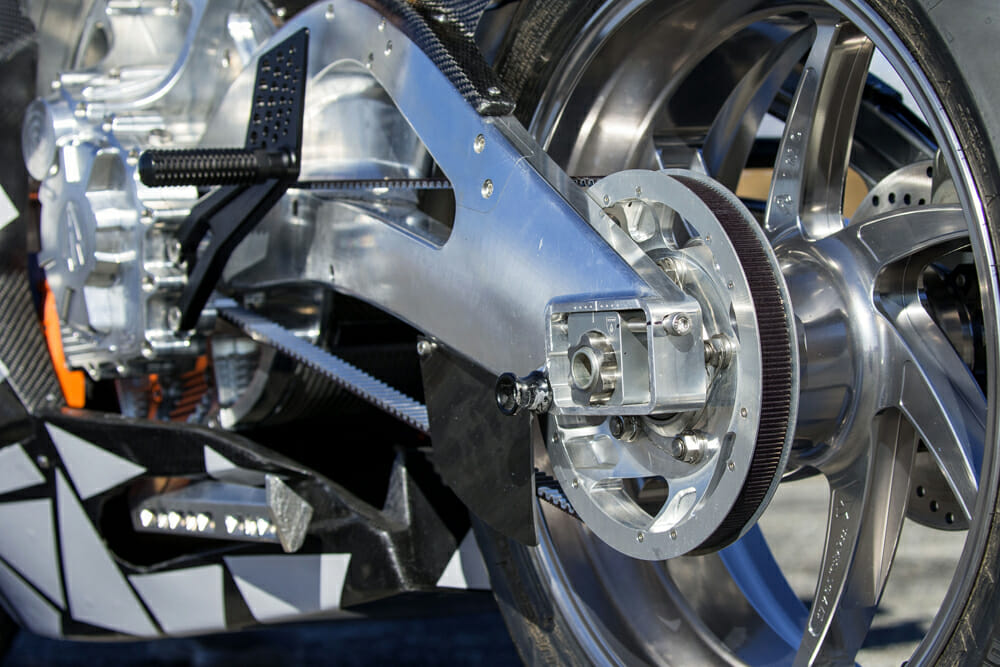 The beautifully crafted swingarm is machined from solid aluminum billet.
The beautifully crafted swingarm is machined from solid aluminum billet.
Oh, yes, the regen. This dual-function regenerative braking from an E-bike is comparable to engine braking on an ICE motorcycle, quite apart from recharging the batteries and thus extending range. This was, however, set much too high on the Strike as I rode it, so maintaining turn speed was hard without consciously accelerating into and round the bend, and at low speeds, I had to be cautious, because the bike reduced momentum so abruptly it risked becoming unstable. At present, the regen could only be adjusted via Hatfield’s laptop, but this is a must-have feature on the bike, just as BMW will let you do on its C-evolution scooter, and indeed Lightning on its LS-218. Still, this meant I could attack Glendora’s twists and turns in something approaching anger while hardly using the brakes going uphill, just backing on and off the throttle. But the Brembo brakes did their usual excellent job in slowing the Strike from high speed in conjunction with the regen, although it’ll be necessary to have ABS fitted, for European sales. It’s coming, says Hatfield. So too, I hope, will be a range of riding mode options for the Strike, with an RBW throttle package there must at least be a Rain mode as well as a Street, and hopefully also a Sport map.
The Lightning Strike has the potential to be a game-changer in the E-bike marketplace. More performance for fewer dollars is a potentially winning formula, and Richard Hatfield deserves enormous credit for creating it, but this time for his business acumen and far-sightedness, as much as for his groundbreaking engineering that’s already been rewarded on the racetrack. I’m looking forward to sampling the finished version of the Lightning Strike in customer-ready form—the next generation E-bike, where performance and allure are combined in a single price-conscious package. CN
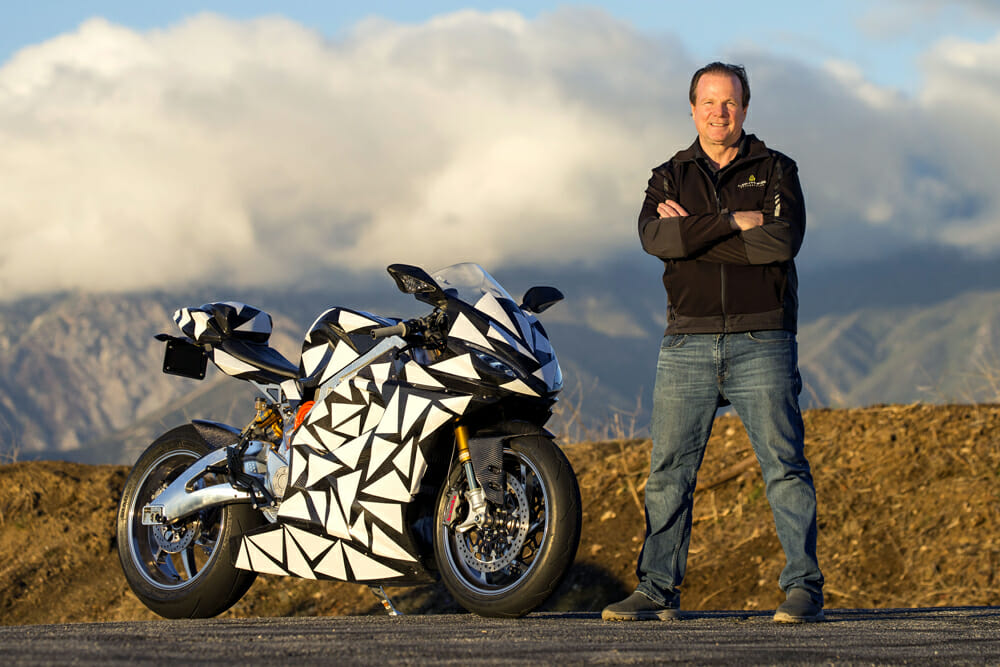 The Lightning Strike and its creator, Richard Hatfield.
The Lightning Strike and its creator, Richard Hatfield.
Lightning Strike Prototype Specifications
| Manufacturer: |
Lightning Motorcycles, San Jose, California, USA |
| MSRP: |
$12,988 |
| Engine: |
150V liquid-cooled three-phase AC induction motor with liquid-cooled inverter/controller |
| Batteries: |
Lightning high-power 18kWh battery packs with integrated thermal management system |
| Output: |
70kw/96 bhp at 15,000 rpm at output shaft (90kW/120 bhp at 15,000 rpm) |
| Maximum torque: |
Constant 95Nm/69ft-lb from 1 rpm upward |
| Range: |
Maximum 120 miles at road-legal speeds with 18kWh battery pack |
| Recharge from zero: |
Under 40 min. with DC charger (3.3kWh charger as standard) |
| Transmission: |
Direct single-speed with belt final drive |
| Chassis: |
Integrated battery shell aluminum monocoque frame |
| Front Suspension: |
43mm Öhlins fork, fully adjustable |
| Rear Suspension: |
Öhlins cantilever monoshock, machined billet aluminum swingarm, no linkage, fully adjustable |
| Head angle/trail: |
24º/4.15 in. trail (adjustable) |
| Wheelbase: |
56 in. |
| Front Brake: |
2 x 320mm Brembo steel discs with 4-piston 2-pad radially mounted Brembo Monoblock calipers |
| Rear Brake: |
1 x 245mm Brembo steel disc with 2-piston Brembo caliper, and supplementary adjustable regenerative braking |
| Front Tire: |
120/70ZR17 Pirelli Diablo Supercorsa SC1 |
| Rear Tire: |
200/50ZR17 Pirelli Diablo Supercorsa SC2 |
| Front Wheel: |
3.50-in. Lightning forged aluminum wheel |
| Rear Wheel |
6.00-in. Lightning forged aluminum wheel |
| Seat height: |
32 in. |
| Weight (wet): |
455 lbs. |
| Top speed: |
150 mph (with track gearing) |